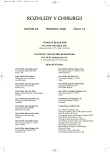The „Inspection Jejunostomy” after Complex Reconstructions of the Central Bile Ducts
Anlage eines Inspektionsstomas bei komplexen Rekonstruktionen an den zentralen Gallengängen
Einleitung:
Hutson und Russell beschrieben bereits 1984 eine Operationstechnik für die Rekonstruktion von komplizierten Gallengangsanastomosen, mit der Möglichkeit des postoperativen endoskopischen Zuganges [4]. Wir stellen eine modifizierte Operationstechnik vor und berichten über unsere Erfahrungen mit dieser Methode, bei der ein Inspektionsstoma bei komplexen Gallengangsrekonstruktionen zum Einsatz kommt.
Methodik:
Nach der Gallengangsresektion erfolgt die Rekonstruktion als termino-laterale Hepatico-Jejunostomie: diese biliodigestive Anastomose wird mit einem nach Roux-Y ausgeschalteten Jejunumschenkel durchgeführt, der anschließend als endständiges Jejunostoma im rechten Oberbauch ausgeleitet wird. Dieses operative Vorgehen bietet die Möglichkeit regelmäßiger postoperativer endoskopischer und radiologischer Kontrollen (Cholangiografie) der biliodigestiven Anastomose; die Stomarückverlagerung erfolgt – bei komplikationsfreiem Verlauf - nach etwa einem Jahr.
Ergebnisse:
Von 03/1995 bis 07/2006 wurde bei 25 Patienten (medianes Alter 62 Jahre) ein Inspektionsstoma angelegt. Indikationen waren vorausgegangene Gallengangsverletzungen nach laparoskopischer (n = 10) oder offener Cholezystektomie (n = 5), Gallengangsresektionen bei einem cholangiocellulären oder Gallenblasenkarzinom mit fraglich tumorfreiem Absetzungsrand bei der Schnellschnittuntersuchung (n = 4), bei einem malignen Granulosazelltumorrezidiv, der zusammen mit einem cholangiocellulärem Karzinom auftrat, einer ausgedehnten fokal nodulären Hyperplasie, einem Mirizzi-Syndrom, einem Zystadenom des Pankreaskopfes mit dünnlumigem Ductus Choledochus, eine Ecchinococcus granulosus Zyste, sowie bei einer Hepaticolithiasis nach Lebertransplantation. Die Eingriffe verliefen alle komplikationsfrei, die postoperativen Kontrollen mittels ERC und radiologischer Gallengangsdarstellung erfolgten in 3-monatigen Abständen über 12 Monate hinweg.
Schlussfolgerungen:
Das sog. „Inspektionsstomas“ im Sinne einer modifizierten Roux-en-Y Hepaticojejunostomie bietet die Möglichkeit, endoskopische und radiologische Kontrollen nach Gallengangsresektionen durchzuführen. Als Indikationen sehen wir komplexe Gallengangsverletzungen, Tumorresektionen mit nicht sicher tumorfreiem Absetzungsrand sowie die rezidivierende intrahepatische Sludgebildung oder Cholelithiasis.
Schlüsselwörter:
biliodigestive Anastomose – Jejunostomie – Gallengangskomplikationen – Gallengangsstenosen
Authors:
C. Knorr 1; S. Kastl, HohenbergerW. 2 1
Authors‘ workplace:
Chirurgische Klinik mit Poliklinik der Universität Erlangen, BRD, Dir. : Prof. Dr. W. Hohenberger
1; Chirurgische Klinik Bundeswehrkrankenhaus Ulm, BRD, Leiter: OFA Dr. R. Steinmann
2
Published in:
Rozhl. Chir., 2006, roč. 85, č. 12, s. 624-630.
Category:
Monothematic special - Original
Overview
Introduction:
Hutson and Russell described in 1984 a surgical technique, where a modified Roux-en-Y hepaticojejunostomy with the afferent limb brought up as jejunostomy after complex reconstructions of the central bile duct was performed [4]. It facilitates endoscopic retrograde access to the biliary tree for control examinations and biopsies in complicated reconstructive procedures after bile duct resection. We report our experience with this operative procedure.
Methods:
After having performed complicated bile duct resection, the reconstruction was performed as a modified Rouxen - Y hepaticojejunostomy with the 20 cm afferent limb brought up as terminal jejunostomy in the right upper abdominal quadrant. Postoperative follow-up comprised endoscopic and radiologic controls of the biliary tree every 3 months for one year; ileostomy resection was performed one year later if the postoperative course was undisturbed.
Results:
From 03/1995 to 07/2006 we performed this operation in 25 patients (mean age 62 yrs.). Indications were previous lesions of the common bile duct after laparoscopic (n = 10) or open cholecystectomy (n = 5), common bile duct resections in cholangiocellular carcinoma and gallbladder carcinoma with unclear intraoperative safety margins (n = 4), malignant granulosa cell tumour and simultaneous cholangiocellular carcinoma, focal nodal hyperplasia, Mirizzi-syndrome, cystadenoma of the pancreas head, cyst of ecchinococus granulosos and one patient with intrahepatic recurrent stone formation after orthotopic liver transplantation. The endoscopic and radiologic (cholangiography) diagnostic procedures – performed every 3 months postoperatively – were uneventful.
Conclusions:
The modified Roux-en-Y hepaticojejunostomy with the afferent limb brought up as jejunostomy permits good control and intervention possibilities in complicated bile duct surgery after bile duct lesions, tumor resection with unclear resectional margins and in recurrent intrahepatic stone formation.
Key words:
biliodigestive anastomosis – jejunostomy – biliary complications – bile duct stenosis
Labels
Surgery Orthopaedics Trauma surgeryArticle was published in
Perspectives in Surgery

2006 Issue 12
- Metamizole at a Glance and in Practice – Effective Non-Opioid Analgesic for All Ages
- Metamizole vs. Tramadol in Postoperative Analgesia
- Safety and Tolerance of Metamizole in Postoperative Analgesia in Children
Most read in this issue
- Consequennce of Nontreatment Scapholunate Instability of the Wrist
- Anterior Skull Base Reconstruction
- Autovenous Ilicofemoral Bypass, 21 Years Later – A Case-Review
- Gastric Carcinoid – A Case Review
